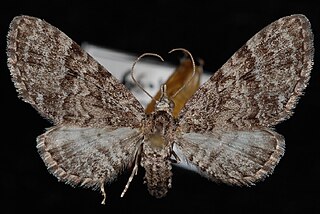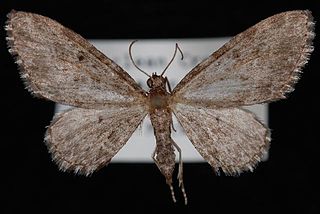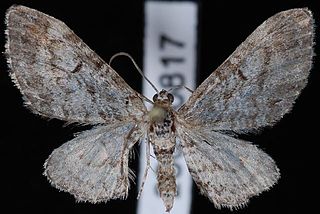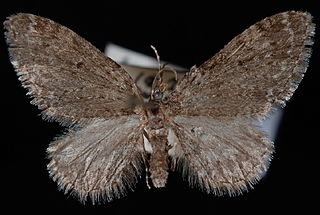
Catocala maestosa, commonly known as the sad underwing, is a species of moth in the family Erebidae. The species was first described by George Duryea Hulst in 1884. It is found in the United States from New York south to Florida and Alabama, west to Texas and eastern Oklahoma and north to Illinois, Indiana and Minnesota.

Eupithecia ornata is a moth in the family Geometridae. It is found from British Columbia and Alberta, south to California, Arizona and Nevada.
Eupithecia edna is a moth in the family Geometridae first described by George Duryea Hulst in 1896. It is found in the southernwestern United States, including Arizona, California, Colorado, Nevada and New Mexico.

Eupithecia borealis is a moth in the family Geometridae first described by George Duryea Hulst in 1898. It is found in North America, including Alberta, Arizona, British Columbia, California, Colorado, Manitoba, Michigan, Montana, New Brunswick, New Mexico, New York, Newfoundland and Labrador, Nova Scotia, Ontario, Quebec, Utah and Wyoming.
Eupithecia sierrae is a moth in the family Geometridae first described by George Duryea Hulst in 1896. It is found in North America, including Colorado, Wyoming, southern Utah, New Mexico, Arizona and California.

Eupithecia nimbicolor is a moth in the family Geometridae first described by George Duryea Hulst in 1896. It is found in North America from eastern Newfoundland and Labrador to western British Columbia and from Alaska to Arizona.
Eupithecia nimbosa is a moth in the family Geometridae first described by George Duryea Hulst in 1896. It is widespread in the Rocky Mountains, from Arizona to the Canada–US border.

Eupithecia multistrigata is a moth in the family Geometridae first described by George Duryea Hulst in 1896. It is widespread in western North America, including the states and provinces of Alberta, Arizona, California, Colorado, Idaho, Montana, Nevada, New Mexico, Oregon, Saskatchewan, Utah, Washington and Wyoming.

Eupithecia lachrymosa is a moth in the family Geometridae first described by George Duryea Hulst in 1900. It is found in North America from central Saskatchewan west to southern Vancouver Island, north to British Columbia and Alberta and south to California.

Eupithecia stellata is a moth in the family Geometridae first described by George Duryea Hulst in 1896. It is found in North America from central Manitoba to northern Alberta and south to California and Mexico.

Eupithecia niveifascia is a moth in the family Geometridae first described by George Duryea Hulst in 1898. It is found in North America from south-western Alberta west to Vancouver Island, north to northern coastal British Columbia and south to New Mexico.

Eupithecia graefi, or Graef's pug, is a moth in the family Geometridae. The species was first described by George Duryea Hulst in 1896. It is found in North America from south-western Alberta west to Vancouver Island, north to Alaska and south to California. The habitat consists of wooded areas.

Eupithecia misturata is a moth in the family Geometridae first described by George Duryea Hulst in 1896. It is widely distributed in western North America.
Eupithecia bivittata is a moth in the family Geometridae first described by George Duryea Hulst in 1896. It is found in coastal central California, United States.

Eupithecia coloradensis is a moth in the family Geometridae first described by George Duryea Hulst in 1896. It is found in North America from western Quebec and western Ontario south to North Carolina, west to New Mexico, Arizona, Colorado and south-eastern Alberta.
Eupithecia cretata is a moth in the family Geometridae first described by George Duryea Hulst in 1896. It is found in the US state of Colorado.
Eupithecia multiscripta is a moth in the family Geometridae. It is found in North America, including Colorado, Utah, Idaho, Wyoming, Montana, Washington and California.

Eupithecia annulata, the larch pug moth, is a moth in the family Geometridae. The species was first described by George Duryea Hulst in 1896. It is found in North America from British Columbia north to the Yukon, east to Newfoundland and Labrador and south to California and Colorado.
Eupithecia implorata is a moth in the family Geometridae first described by George Duryea Hulst in 1896. It is found in the US states of California and Arizona.
Eupithecia cestata is a moth in the family Geometridae first described by George Duryea Hulst in 1896. It is found in the US state of California.












